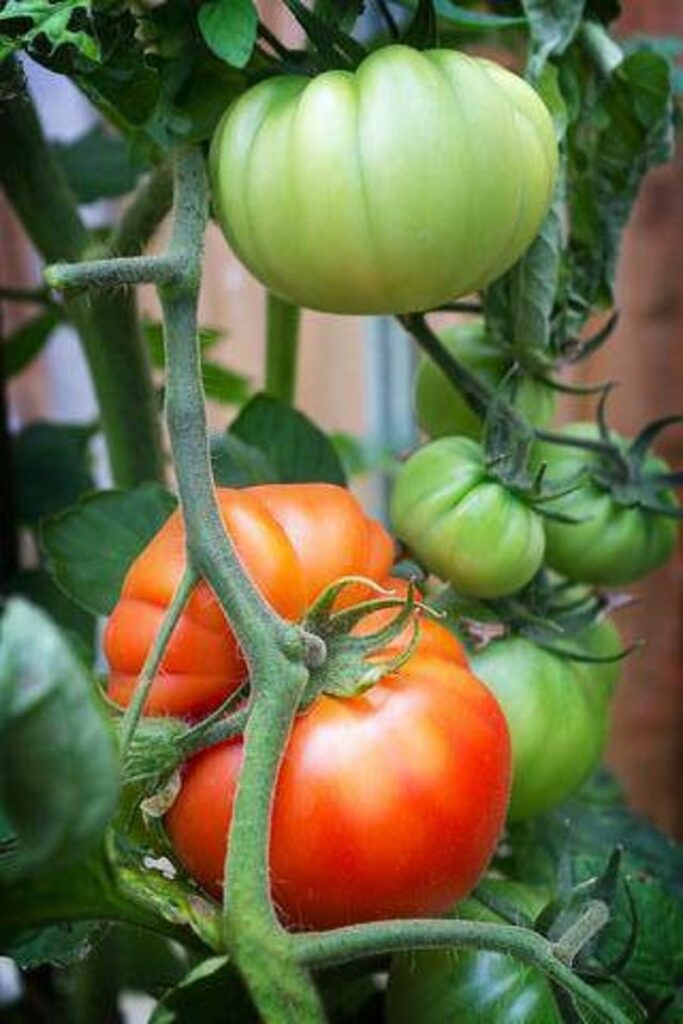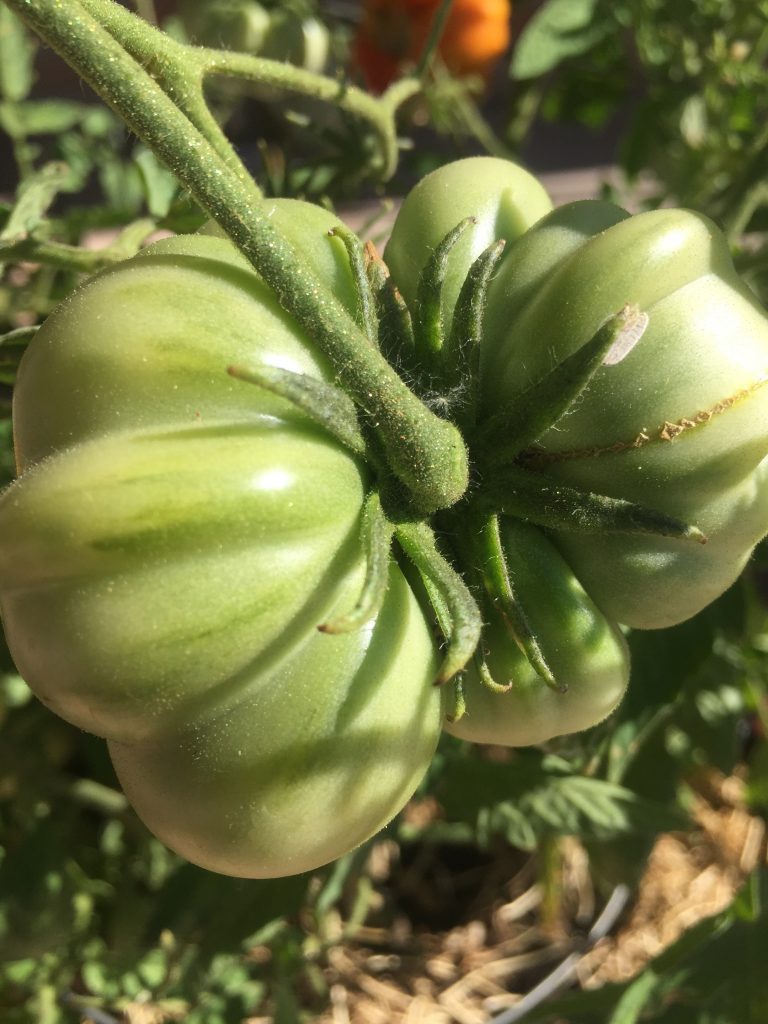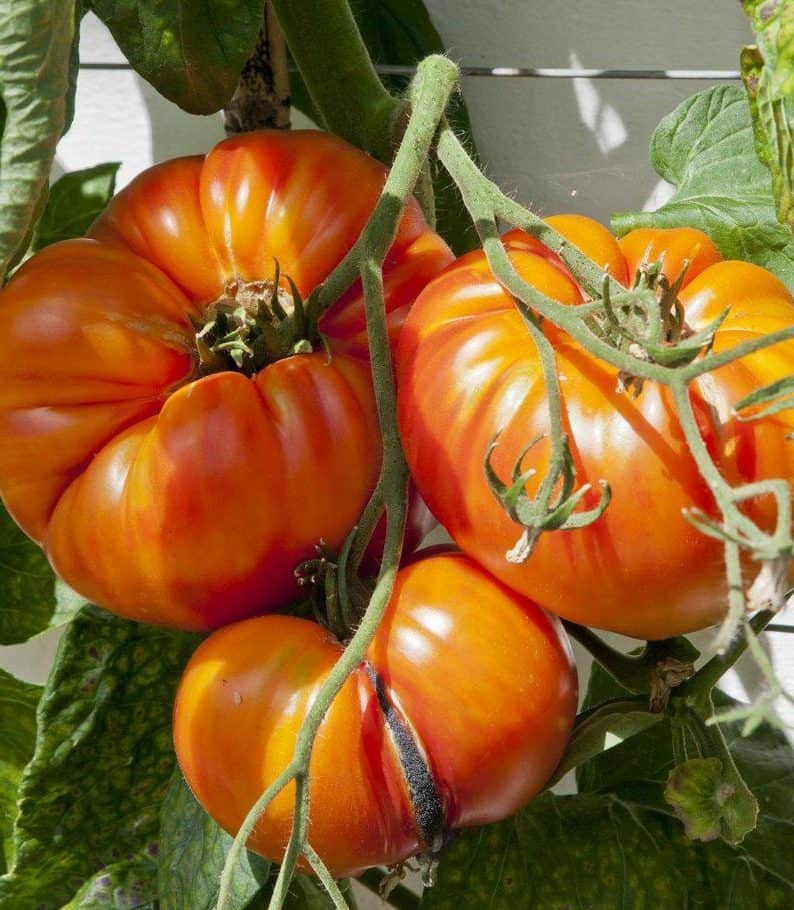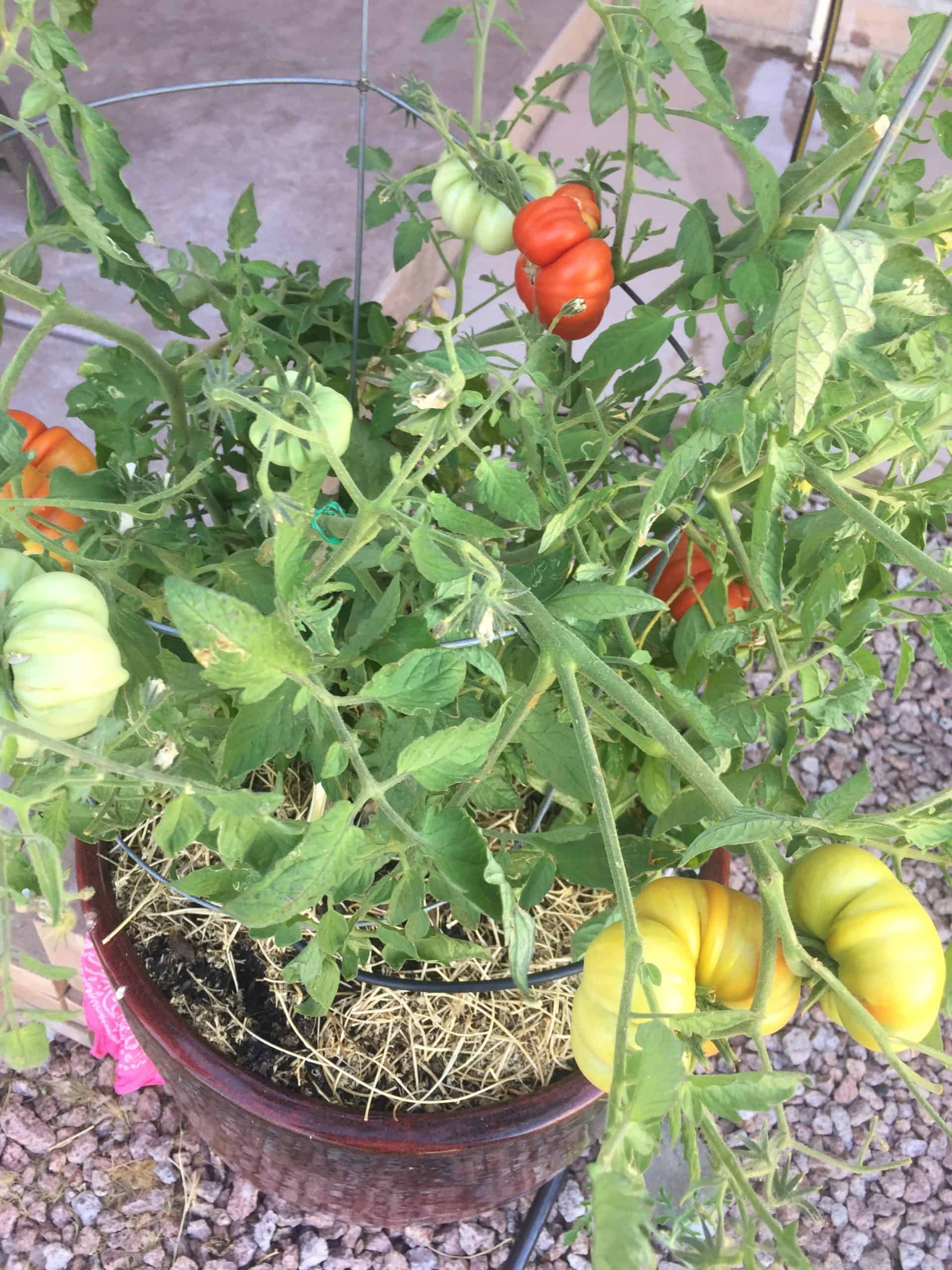Beefsteak tomatoes are easy and fun to grow in your home garden. They can grow to be a pound or more each. Whether you’re slicing them for sandwiches, dicing them up for a quick pico de gallo, or eating them straight off the vine, there’s no way to go wrong with beefsteak tomatoes.
I love planting them in my garden. Here’s what to know about the meaty beefsteak tomato: What it is, how to use it, and how to grow a beefsteak tomato plant with lots of juicy tomatoes.
What are Beefsteak Tomatoes?
The scientific name is Solanum lycopersicum. Tomatoes are nightshade plants and are considered warm season vegetables. Beefsteak tomatoes, or beef tomatoes for our friends across the pond, are among the largest varieties of tomatoes, with fruits regularly growing to one pound or larger.
The fruits are typically bright red or pink. They are fleshy with many seeds, and they’re prized for their large size and pleasing, mild taste. Most beefsteak varieties have a deep-set stem and ridges. They aren’t smooth around like other tomato varieties.
Beefsteaks are indeterminate tomatoes. This means beefsteak tomato plants will continue to grow and produce fruits throughout the season instead of all at once like with determinate tomatoes. As they continue to grow, you’ll need to ensure you have sturdy stakes or tomato cages surrounding each plant for support. They grow almost like vines and will spread out.
They will grow as long as you take care of them until frost kills them. They are annuals. You’ll need to replant the following year.
It’s important to prune indeterminate tomato plants so the plant can use the energy to produce more tomatoes. To do this, look for suckers which is the growth between the stem and the branches. Gently pluck them off from the lower section of the plant. This way, the plant will use energy to grow beefsteak tomatoes.
The important thing to remember is they are indeterminate tomatoes so they will need space to grow.
What are Beefsteak Tomatoes Good For?
There are lots of things to do with beefsteak tomatoes. These thick and fleshy tomatoes are ideal for slicing for sandwiches or burgers, and this use is where they derive their namesake.
Still, they are far more than a sandwich topping. They’re also an ideal variety for tomato salad, Caprese salad with leaves from your own basil plant, and any other salads.
Their mild taste also makes them a great base for sauces and dips. They are flavorful and not acidic.

Why Grow Beefsteak Tomatoes
Beefsteak tomatoes are an ideal variety to grow at home for several reasons. Not only do beefsteaks lend themselves well to some of our favorite summer dishes, but they also look lovely in your garden.
They are also easy to grow in home gardens.
Plus, beefsteak tomatoes don’t grow well when farmed commercially, so they’re often difficult to find in large grocery stores. Unless you have a farmers’ market or local grocer who stocks them, growing your own may be your only way to enjoy these delicious tomatoes this summer.
And of course, there’s nothing better than a juicy homegrown tomato! Here’s everything you’ll need to know to grow your own delicious beefsteak tomatoes.
How to Grow Beefsteak Tomatoes from Seed
These tomatoes have a long growing season. In most parts of the country, the weather isn’t cooperative enough to grow your plants entirely outdoors. Start by germinating seeds indoors to protect the delicate seedlings from the cold.
The rule of thumb is to plant your tomatoes outside about two weeks after the last frost of the season, once soil temperatures are around 60°F. Depending on where you live, the time to start germination will vary. Most people begin sowing their seeds in early March, so the seeds are ready for planting in early May.
You can begin germinating your seeds in flats or small parts. There are many ideal substrates you can use, such as seed starting soil, potting soil, or peat pellets.
Once you have your container and growing medium sorted out:
- Place two beefsteak tomato seeds in each container.
- You’ll want to plant them about three times as deep as the size of the seed. In most cases, this is about ¼ – ½” deep.
- Place in an area with sunlight.
- Water when the soil is dry.
- Let the seedlings reach about eight inches tall before hardening them off.
- Planting outdoors.
Your seedlings will germinate well if you keep them in a warm place that receives plenty of sunlight. After 7 – 14 days, your seeds will germinate and begin to grow.
Growing Tips
While they will thrive in light for up to 16 hours per day, they need a dark period in order to grow. If using grow lights, don’t leave them on for 24 hours.
They’ll also need to be hardened off before planting outside. Keep them outdoors for a week with some protection from hot sun and extreme temperatures. After you’ve acclimated them to the outdoors for a week, you can plant them. Transplant seedlings into garden bed or right in the ground provided you have nutrient-rich soil.
You can also plant them in containers. Growing tomatoes in pots outdoors is a way to keep predators away and also are ideal for smaller spaces or if you don’t have a garden plot. The downside to growing beefsteak tomato plants in pots is that because they are indeterminate, you will need a large pot as well as a support system.

Beefsteak Tomato Starts
If you get started later in the season or don’t want to plant beefsteak tomatoes from seed, you can buy tomato plants that are already growing. These are called starts.
You can find beefsteak tomato starts at garden centers and nurseries, home improvement stores, and hardware stores. This way, you will be starting with an established plant and won’t have to germinate seeds.
Opting for tomato starts instead of seedlings means you start with small plants that are several weeks old. Depending on their size, they may require a few more weeks inside to harden off, or they may be ready for planting outside right away.
Planting Outdoors
Tomato plants love full sun. They require a minimum of six hours of direct sunlight per day. Once the weather is cooperating, move your plants to a garden bed that receives plenty of sunlight and drains well. Ideal soil temperature should be 65 degrees F or warmer.
If you live in a colder area, you can cover your planting area in black plastic several weeks before planting to warm up the soil before planting.
Before planting, work some compost and starter fertilizer into your soil, so the young beefsteak plants have plenty of nutrients. The soil should be well-draining.
Ideal pH level is between 6 – 6.8 which is acidic soil.
Give each plant about 4 – 5 feet of space, depending on the type of beefsteaks you plant. This will give you plenty of room for supports while still allowing for good air circulation. Also, it will allow the area to dry out after heavy rainfall, preventing rotting and mold.
The plants will continue growing and will need room. Plants such as Cherokee purple can spread to 18 inches. Some varieties, such as Super Beefsteak, can have a 36 – 48 inch spread.
You may choose to use cages, trellises, or stakes to tie off your plants depending on which you prefer. Most growers choose cages for beefsteak tomatoes, as they offer better support for the heavy fruit the plants will soon begin producing.
Center the cages around the plants when they small or medium sized. It will be too difficult to do when they are larger, and you don’t want to risk breaking off or damaging branches.
Plant the beefsteak tomato plant as deeply as possible once you move them outside, allowing only the top few leaves to poke through the surface to promote strong and healthy root systems. You can remove bottom leaves.
Water after planting taking care not to wet the leaves. In most climates, a beefsteak tomato plant will need 1 – 2″ of water each week. Water in the evening. In dry climates, water more frequently.
Remember to prune these indeterminate tomato plants.
Harvesting
It’s important to know when to pick beefsteak tomatoes. In optimal conditions, a beefsteak tomato plant will take about 80 days to produce fruit that’s ready for harvest. Some varieties produce as soon as 75 days, while others take longer, up to 85 days.
Most plants take about 30 days to begin showing fruit, and from that point, it takes another 40 – 50 days for the fruit to reach maturity.
When planting from seeds or starts, be sure to check the days to maturity for the type of beefsteak tomato plant you have. This will give you an idea of when the tomatoes will be ready to harvest.
Most types of beefsteaks will have tomatoes ready to harvest in 80 – 85 days. Keep in mind, beefsteaks will continue to produce throughout the growing season.
You’ll want to pick when the tomatoes are red and ripe. Gently twist the fruit while pulling gently. The tomato should come off the vine easily. If you have pests or split tomatoes, you may need to pick them when they are green. In these instances, learn how to ripen green tomatoes.
Beefsteak Tomato Varieties
- Super Beefsteak
- Big Beef
- Red Beefsteak
- Beefmaster
- Heirloom Beefsteak
- Brandywine Red
- Brandywine Pink
- Cherokee Purple
- Black Krim
- Brandy Boy
- Patty’s Yellow Striped Beefsteak
Why Do Beefsteak Tomatoes Split?
One of the problems with growing larger tomatoes is sometimes they split open. It’s common for many tomato varieties including beefsteaks to split. While it isn’t ideal, it’s completely natural and nothing to be alarmed about.
Tomatoes split most commonly when the fruit itself is growing faster than its skin will allow. Periods of heavy rain followed by dry weather can often cause tomatoes to split on the vine.
If you notice tomatoes that have split, you’ll want to remove them from the plant and allow them to continue to ripen indoors.

Bringing them indoors will help keep the fruit from rotting, so you’re still able to enjoy it when it’s ripe. Harvesting split tomatoes also keeps the insects from eating them.
A tomato that’s split can still be quite delicious, but they usually aren’t as flavorful as a tomato that ripens completely on the vine.
If the fruit begins to ooze, or you notice a sour smell coming from it, you’ll want to toss it into the compost pile.
Pruning
Because they are indeterminate, it’s important to prune the suckers that form. Remove the growth that you see between the stem and branches. This will redirect the plant’s energy into growing more tomatoes. Remove the suckers from the bottom of the plant, not higher up.
Growing Tips
It takes time planting and watering to grow tomatoes. It also costs money, especially if you buy bought organic soil and fertilizer. You’ll want to be sure to maximize your yield by growing as many as possible.
Use these tips for how to grow beefsteak tomato plants from seeds:
- Start with your best seedlings. Don’t bother with any weak or small seedlings as they aren’t likely to produce strong plants. Snip off the weaker plants and keep the strongest.
- Unless you can provide seedlings with 14 hours of direct sunlight each day, invest in a small fluorescent grow light to ensure strong and hearty seedlings.
- A nice breeze helps tomato plants grow strong stems. Give them an early start by turning a fan on near your seedlings for five to ten minutes twice each day.
- Savvy gardeners often leave their seedlings on top of their refrigerator or another appliance that throws off heat to help the germination process. Just be sure there is light.
Companion Plants
Beefsteaks grow well with other tomatoes. If you want to add some diversity, you can grow with parsley, oregano, chives, and pole beans.
While they will do well with peppers, it’s best to plant them together every other year if you are planting in the same location. If you change locations, you can plant them together.
Pests
Avoid planting beefsteak tomatoes with corn and potatoes. These can attract pests. You can grow beefsteak tomatoes in pots which may alleviate some of these issues.
Some to watch for when watering tomato plants or harvesting beefsteaks are:
- Tomato hornworms – These are thick green caterpillars that are difficult to spot on tomato plants, especially large vining plants. They blend in the foliage very well. Watch for signs of damage: partial leaves, bite marks, deleafing. Learn how to get rid of tomato hornworms as soon as you notice a problem.
- Cutworms
- Spider mites
- Stink bugs
- Colorado potato beetle
- Ants
- Birds, deer, and rodents will also eat them
How Tall Does a Beefsteak Tomato Plant Get?
Most beefsteak varieties will grow to three feet or higher. Some can grow 6 – 8 feet tall. It’s important to give them space as they can spread anywhere from one and a half to four feet wide.
Support the plants with tomato cages, stakes or trellis them. Beefsteak tomatoes can weigh a pound or more at harvest time. Supporting the plant will allow them to focus energy on growing more tomatoes.
Conclusion
Few things are more enjoyable than a delicious beefsteak tomatoes on a hot summer day. Popular to grow in home gardens, beefsteak tomatoes are fun to grow, pick and eat. Appearance-wise, they are considered ugly tomatoes by some as there are seam-like indents in them.
There are lots of things to do with beefsteak tomatoes. They are ideal slicing tomatoes, plump and meaty. And they are delicious!
However, if you live in a hot dry climate, you may opt for growing smaller tomatoes such as roma tomatoes or cherry tomatoes which will be fully grown and ready for harvest sooner than beefsteaks.
Once you’ve perfected growing them in soil, you may want to consider learning how to grow hydroponic tomatoes.

